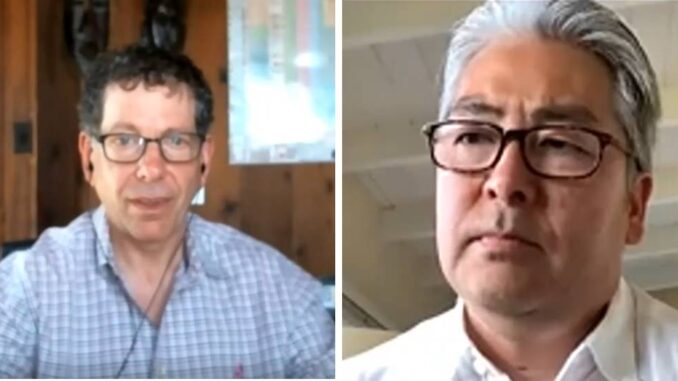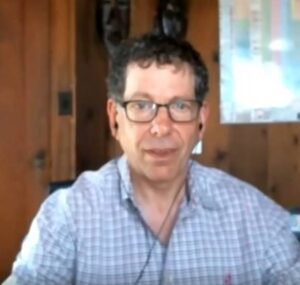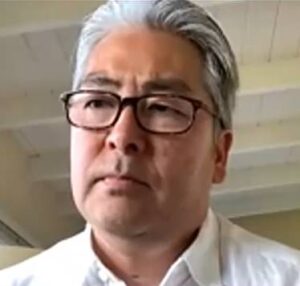
By Fraser Perkins —
The theme of the June 13 virtual Palos Verdes Democrats’ meeting was Stop Dumping Patients – Advocating for Nursing Home Reforms. The presenters were Matthew Borden, a partner and cofounder of the law firm BraunHagey and Borden, and Al Muratsuchi, Assemblymember for the 66th Assembly District.
Editor’s Note: To help the reader delve more deeply into the details of the presentation, we’ve annotated the time (e.g. 1:30 is 1 minute 30 seconds) that the discussion occurs in the video. The video is provided at the end of this article.
00:15 Introduction
During her introduction of today’s speakers, moderator Ann Nye shared with us their back stories, which you can read about in her Did You Know newsletter article.
Matthew Borden’s law firm has secured high profile judgments in impact cases involving “Black Lives Matter” protests, nursing home dumping, human rights advocacy, and environmental issues.
03:38 Matthew Borden
Mr. Borden highlighted dumping and illicit sedation of residents as the biggest threats to senior residents of nursing homes. He noted that nursing homes have responsibilities beyond just a landlord-tenant relationship. A nursing home has an obligation to take care of its residents. Dumping is a special concern as it is a cause of “transfer trauma,” the mental trauma suffered by dementia residents when they are abruptly moved from a familiar environment to an unfamiliar setting.
05:52 Dumping
Mr. Borden continued by presenting an overview of dumping, “What is dumping, Why is it a problem and What are we doing about it?” He linked dumping to the financial incentives caused by nursing home reimbursement. There are three reimbursement schedules:
- Medicaid
- Medicare = Medicaid rate + $1,000/per resident per day
- Private Pay
Medicare is a short-term program allowing a facility to collect the Medicaid daily rate plus an additional $1,000/resident/day. A nursing home wishing to maximize profit seeks to reduce its Medicaid residents and replace them with Medicare residents. He contrasted the payout to a hypothetical nursing home chain with 30 facilities, each with 100 residents, under a complete Medicaid population versus a complete Medicare population. The additional revenue for the straight Medicare population is as follows:
(30 facilities)(100 residents/facility)($1,000/day)(365 days/year) = approximately $110,000,000 per year
Mr. Borden next divided dumping into three categories – the hospital dump, the pressure dump and the insurance dump.
Hospital Dump –
Mr. Borden described the hospital dump as a situation where a nursing home facility transfers a resident to the hospital and then refuses to take them back after being discharged from the hospital. He made an analogy to a landlord changing the lock while a tenant was visiting a doctor. “You can’t do this.” There are strict protocols prior to discharge from a nursing home. The nursing home must secure a doctor’s agreement that a discharge is warranted, it must obtain another location for the transferee, and it must provide adequate orientation to the new facility for the transferring resident.
Pressure Dump –
A pressure dump occurs when a facility or its employees pressure a resident or the resident’s family to transfer a resident. The facility may say to the resident, “We can’t take care of you.” This is an illegal pressure tactic.
Insurance Dump –
An insurance dump is when a private pay insurer decides a resident has recovered and won’t pay for additional services.
Mr. Borden continued by noting that although the law is favorable for nursing home residents, the state has done nothing to enforce existing laws. His firm has brought suit against the state of California for failing to enforce existing laws. Following discharge from a hospital, a nursing home resident is entitled to a hearing if the facility refuses to take them back. Following a hearing, the state will issue an order to determine if a facility must accept the return of a resident. Unfortunately, “California has not been enforcing readmission orders.”
13:51 California Health & Human Services (CHHS) Agency
CHHS contains a labyrinth of agencies which complicates nursing home care. One of its agencies, the Department of Health Care Services (DHCS) provides the hearing for nursing home residents appealing a dump. Once DHCS issues an order, they consider their involvement finished and shift enforcement to another agency, the California Department of Public Health (CDPH), also under CHHS jurisdiction. CDPH in turn has adopted the position that it won’t enforce rulings of DHCS because CDPH wasn’t present at the hearing. The Ninth Circuit has described this situation as, “a meaningless show trial because everyone understands that you don’t have to obey this piece of paper.”
15:56 Nursing Home Cases
Mr. Borden mentioned several cases where nursing home residents won their cases at a hearing, but the facilities refused to readmit them. In one, the Gloria Single Case, a resident with dementia was transferred to a hospital for an unneeded psychiatric evaluation, then was refused readmission back to her nursing home. The nursing home, owned by the Retirement Housing Foundation and run by Laverne Joseph, has engaged in prior cases involving dumping and understaffing its facilities.
Mr. Borden concluded by showing an org chart for one chain of six nursing homes. There were 29 interlocking entities involved in providing care. This convoluted structure is deliberate and makes the finances and chain of responsibility all but impossible to understand.
25:35 Assemblymember Al Muratsuchi
Moderator Ann Nye, introduced Assemblymember Al Muratsuchi who represents the South Bay. Assemblymember Muratsuchi has sponsored two bills in 2021 focused on nursing home reform, AB 279 and AB 1502, as well as legislation dealing with recovery from the COVID pandemic, environmental justice, and closing the digital divide.
Assemblymember Muratsuchi reiterated that enforcement of existing state laws is a major challenge. He continued by noting that during the early phase of the crisis, half the COVID deaths were in nursing homes. Spurred by an attempted conversion of a nursing home to luxury apartments In Boyle Heights, Assemblyman Muratsuchi, with support from the California Advocates for Nursing Home Reform (CANHR), sponsored AB 279 which prohibits all nursing home transfers during the COVID crisis, unless medically necessary. Passed by the Assembly, AB 279 now awaits a hearing by the California Senate Health Committee. Another assembly bill, AB 1502, seeks to strengthen CDPH’s ability to regulate nursing homes.
Assemblymember Muratsuchi next focused on another abusive tactic of nursing homes, “squatting.” Citing Brisas Health, a hospice and palliative care facility, as an example, “squatting” involves acquiring bankrupt nursing homes and operating them under interim management agreements for up to five years, before obtaining a renewed license. He noted that the nursing home industry has become profitable by relying on taxpayer dollars. “Eighty-five percent of nursing home revenue comes from either Medicare or Medicaid.” He reiterated that a major tool of nursing home operators is opacity, using multiple interlocking entities to provide care.
38:30 Questions & Answers
Can you provide comments on how dumping affects intermediate care, assisted living, hospice, and other types of care facilities?
Borden – Enforcement tools are available to end dumping, but the penalties must exceed the benefits of dumping – the additional $1,000/day for each Medicare resident.
Muratsuchi – The current fines are ineffective, a mere “slap on the wrist.” Some nursing home operators have dumped residents in homeless shelters. Brisas Health has received over $800 million in public funding in addition to CARES Act funding. Assisted living is separate from nursing homes; assisted living facilities do not get federal funding and are less regulated. Yet, “memory care starts to look a lot like skilled nursing.”
Is the basic issue a lack of resources, or is it a more systemic lack of enforcement?
Muratsuchi and Borden – lack of resources and enforcement as well as “agency capture.” [Editor’s Note – agency capture is defined as the capture of the regulatory process by those it is supposed to regulate who then turn control to their advantage.]
How can the public support enforcement of existing laws?
Muratsuchi – Powerful forces such as the California Association of Health Facilities (CAHF) and the California Hospital Association (CHA) oppose change. The public needs to contact their representatives to apply pressure against these influential lobbyists.
Borden – The complex web of entities within an organization allows profits to be smuggled within the organization. One entity may be insolvent, while other entities, also within the organization, are highly profitable. A nursing home may appear to be insolvent, because the profits are reaped elsewhere within the organization.
Muratsuchi – “Operators run circles around regulators.” It amounts to a corporate shell game.
How is this analogous to Dialysis Clinics?
Muratsuchi – A somewhat similar situation exists with dialysis centers who wish to “capture” patients and lack incentives to encourage patients to sign up for kidney transplantation. The penalties for this type of behavior are minimal.
What’s holding up legislation in Committee?
Muratsuchi – AB 1502 is held up in the Assembly Health Committee, headed by Jim Wood. AB 279 (preventing transfers) awaits a hearing by the California State Senate Health Committee.
What do you think of a medical director of a facility who self-refers patients?
Muratsuchi – “Should be prohibited by law.”
1:07:23 Closing Remarks
Borden cited payments, lack of transparency, complex corporate structuring, shoddy care and dumping as major issues in nursing home management.
Muratsuchi – believes nursing home care touches the issue of a single payer health system. In seeking nursing home care, he recommended one look for non-profit nursing homes. He urged participants to fight for transparency. He strongly believes public funds should make health care work for all of us.

Leave a Reply